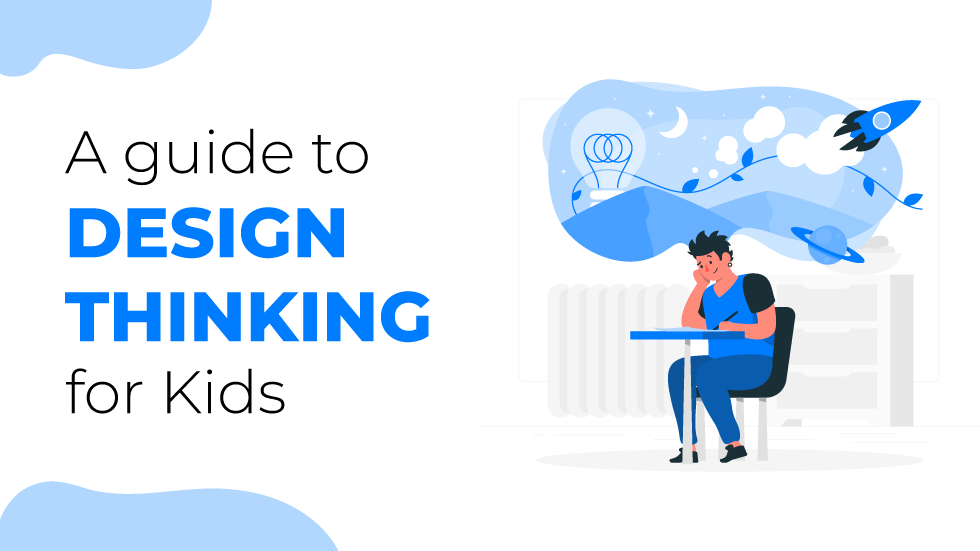What is Design Thinking?
Design thinking is the process of creating a product from scratch to finish, ensuring it is right for the person who needs to use it. This is a powerful tool for innovation and delivering creative solutions. It is a mindset that helps you create those Innovators.
In simple words, design thinking is a “solution-based” technique to solve a problem.
It creatively keeps individuals engaged in opportunities to empathize and understand the needs of the people they are designing for, identify or re-define problems, brainstorm and generate ideas, and finally, test and evaluate the ideas using prototypes to learn and get the best solution. The process of ‘Design Thinking was popularized by David Kelley, the founder of the design firm IDEO and Stanford’s d.school.
He puts it in a simple statement:
“Design thinking relies on the natural — and coachable — human ability to be intuitive, recognize patterns, and construct ideas that are emotionally meaningful as well as functional.”
What skills can Design Thinking nurture?
The process of design thinking can develop and nurture your child in several ways:
-
Design thinking can help your kids to solve their problems.
-
Working through problems can help increase self-confidence.
-
It fosters creativity and original thinking.
-
It can develop an awareness of the needs of people around them.
-
Design thinking can also stimulate curiosity and questioning.
Why is it important?
We all have been there where we were asked to score well in our exams. The system emphasized better marks over understanding, questioning, and creating. However, there is a dire need to change this system; how?
Well! An answer to it is introducing design thinking adapted for kids. As mentioned above, it is an approach to learning that focuses on developing students’ creative confidence—teaching them to celebrate design and bring about problem-solving to drive innovation.
You can organize workshops designed specifically for kids to cultivate creative confidence and collaborative skills, deepen observation, develop empathy, and align them around specific goals and results. Kids have an innate quality of curiosity and questioning, which can help them discover opportunities that everyone cannot see. Moreover, you can help kids be great problem solvers, future leaders, or visionaries by injecting design thinking into early education.
How to teach Design Thinking?
To help kids master Design thinking has five different “spaces.”
Empathize
Empathy is a cornerstone of human-centred design thinking. Observing people – what they do, how they live, and their stories – is crucial to creating an innovative solution to a problem. Such observation helps understand how they think, feel, value, and look at the world. Most importantly, empathy includes a degree of engagement with people. It can be a conversation or a step-by-step understanding of how things are done.
Define
Defining a question or challenge based on empathy often changes the initial problem you thought you had figured out while resolving a problem.
Defining a problem/challenge based on user needs provides direction, frames the problem, inspires and holds accountability, informs the evaluation criteria of competing ideas, and keeps the question in the area of “achievable.”
Ideate
Ideate is the space to envision various “wild, cherished and practical” ideas without judgment. It discourages linear thinking and helps people overcome obvious solutions.
This step will help celebrate the power of possibility!
Prototype
After getting ideas, it is time to experiment with prototypes. A prototype is a potential solution that leaves time for feedback. The prototypes are simple: storyboards, handmade mock-ups, posters, or role-plays. It is important to create something very quickly to determine whether the answer to the original question was given. The question may have been incorrect, and it is time to go back to square one. It is best to fail early and inexpensively before proceeding to formal assessments.
Test
Testing is the culmination of empathic-defined-idealistic-prototype spaces of conceptual thinking. The problems have been framed and reformulated. Now, get kids involved in real-life, real-time testing in which others are involved. Only when we allow ourselves, our teams, or our students to experience spaces of conceptual reflection can we implement authentic evaluations.
The concept is active and inclusive. What’s more, children embrace design thinking with enthusiasm. Across the globe, schools are embracing design thinking as a new way to learn and increase student participation. It should be on our education agenda. Of course, this is more complicated than standard repackaged evaluations. However, conceptual thinking gives children golden opportunities for commitment and creativity, two prerequisites for true learning.
Fun activities to teach Design Thinking
What additional steps should be taken? If you’ve any, let us know in the comments.
